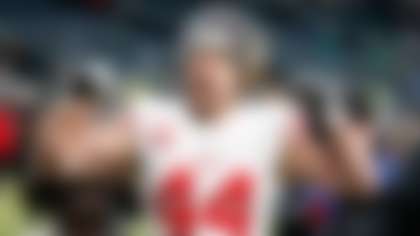With only "Monday Night Football" left to play in Week 11, the playoff picture is starting to come into focus -- and four teams are currently projected to reach the postseason in 95 percent of my model's simulated outcomes: the Kansas City Chiefs, Los Angeles Rams, New Orleans Saints and New England Patriots.
Here's how the model works: First, I use 15 seasons (2003-2017) of contextualized statistical, situational and matchup data to create team and game profiles. My blend of stats and football theory are vetted by both the best advanced math and traditional football minds, including 17 past and present coaches. Current season data is then organized in the same way. The model compares this season's team and game profiles with the historical data to find "look-alikes." For example, the Jags' and Saints' respective offenses operate quite differently, meaning the units score (or fail to score) touchdowns in different ways -- even when facing the same opposing defense. And thus, they have different historical "look-alikes." Teams also evolve over the course of a season. Most obviously, injuries significantly impact rosters, but in order to keep the model's accuracy high from week to week, you also have to routinely factor in things like rookie learning curves, free agents settling into schemes and play callers implementing different plays.
The historical game attributes and outcomes are compared with this season's matchups to create each game projection. Since there are multiple "look-alikes" for each team -- and each phase of the game -- I choose to run 10,000 simulations for every game. Not only does this give me a win percentage for a team, but also a final score projection and a sufficiently large sample of scenario analyses that allows me to see which attributes of the teams and matchups are most influential to wins and losses. One quick example: Yes, it's true that turnovers are strongly correlated with game outcomes, but not all turnovers are equal; a turnover's relationship to the team's ability to win depends on how an offense operates, whether or not the team is playing with a lead, and when the turnover occurs.
Simulating the rest of the season using this same "look-alike" strategy (yes, 10,000 times for each remaining game) creates a forward-looking playoff projection model that not only reveals the likelihood of making the postseason, but also identifies evolving team attributes and spotlights which matchups they will be most pivotal in.
Now, onto the real reason I'm writing this piece right now: Those four aforementioned teams that are virtual locks for the postseason.
The Chiefs (9-1) and Rams (9-1) are both 99.9 percent likely to hit the playoffs, according to my model, while the Saints (9-1) hold a 98.8 percent chance and the Patriots (7-3) sit at 94.9. These teams will be playing in January. It's defensible to say they are the four best teams in the league right now. All have premier impact players and coaches who are the most effective at quickly adapting based on the situations they find themselves in.
With that being said, my idea here is to lay out a few things we can track over the remainder of the season, to see how these four elite teams evolve and strategically set themselves up for success -- or where they could be vulnerable -- in the postseason.
Also, there's a decently exciting game between my model's two highest-probability teams tonight -- Chiefs at Rams -- which could hold some big clues about the path to Atlanta. So, let's start with a deeper look at the two clubs facing off on national TV tonight:
Kansas City Chiefs
The brilliance: The most offensive diversity, with top-five impact players at the QB, RB, WR and TE positions.
No team has more drives of five or fewer plays that have resulted in scores than the Chiefs. Kansas City boasts the highest overall offensive rating, thanks to the on- and off-ball impacts of each of their offensive skill positions. Think of these as the numbers that appear on stat sheets combined with things like running backs picking up blitzing defenders or wide receivers drawing the coverage of multiple defensive backs (leaving another pass catcher with a more favorable matchup). Based on the historical comparables, K.C. has the highest scoring-potential ceiling of any team -- not just in 2018, but over the entire sample dating back to 2003.
Situation to monitor: The rush defense, especially on outside runs.
The Chiefs' defense gives up the third-most yards per game (410.7). Their 24 points per game allowed ranks 17th. That said, Kansas City's pass defense has faced an average of 45 pass attempts per game, which is almost 10 more per game than the league average of 36. On this incredibly high number of passes, the Chiefs average the sixth-lowest passer rating allowed (87.5). Simply put, the pass defense is better than it seems. The run defense, however, allows the third-most yards per rush (5.07) and it's primarily due to outside rushes. Chiefs opponents are running for more than 6.2 yards per carry when rushing wide to the right and 8.6 yards per carry when rushing wide to the left.
Strategy to monitor: In-game play-calling adjustments.
Computer vision shows that when down D-linemen don't get off their blocks quickly, rushing averages increase. The Chiefs' defense ranks in the bottom eight this season when it comes to block-shedding speed. The good news: Defensive rushing vulnerabilities on outside rushes, when compared with inside-the-tackles gains, have not been as punishing to win totals based on the historical model ... assuming offensive efficiency is the same. That last part is key with this team and this coach. Anyone who has tracked Andy Reid's career knows there are two areas where he catches some flak: red-zone scheming and general clock management. So, I dug deeper on both ...
When he arrived in Kansas City, Reid implemented a more horizontal offense than he'd featured in Philadelphia. And now, layering in quarterback Patrick Mahomes' ability to operate effectively outside the pocket (644 yards gained, per Pro Football Focus, which is more than 200 yards clear of the next-closest quarterback) and deep-passing prowess (his 21 completions of 21-plus yards pace the NFL), it seems like Reid has added the final piece to his philosophy. The question here is far less about the red area, but more about the clock-management challenge of keeping the defense off the field, especially should the offense slow its scoring pace. (Kansas City averages 3.44 points per drive; playoff teams in the sample typically average about 2.5 points per drive.) I'm not suggesting Reid limit Mahomes' passing or ability to create gains when plays break down in any way -- but rather, that strategic increases in run play-calling could create an insurance policy in case the Chiefs' scoring sputters and they need a few offensive drives to adjust to defenses who now have more film on Mahomes and are likely to better scheme for his unique skill set.
Los Angeles Rams
The brilliance: Constant threat of explosive offensive plays disguised by simple-looking pre-snap formations.
The Rams have deployed 11 personnel (one running back, one tight end, three receivers) on 96 percent of their plays and used play-action on 38 percent of their passing plays -- both NFL highs. The constant dual-threat of Todd Gurley combined with a bevy of potent receiving options and an offensive line that keeps Jared Goff clean has been L.A.'s formula for success.
Situation to monitor: Big plays given up by the defense, especially on the ground.
The Rams hope to get Pro Bowl cornerback Aqib Talib back from injury after their Week 12 bye, so I'm going to focus on defending the run here, because it's more unclear how they will address this problem. The Rams have given up 39 rushes of 10-plus yards (tied for fourth-most) and 28 of 12-plus (also fourth-most). Measuring the down lineman's hips and shoulders at the time of first contact with opposing running backs, the Rams are at 45 degrees or more 42 percent of the time, which is the third-highest rate in the NFL. That's not a good thing. Think of it like this: Horizontal hips and shoulders are like a wall; whereas, the more perpendicular hips and shoulders are, the easier it is for a tackle to be ineffective, allowing the runner to slip through. Notably, no team has given up a higher yards-per-carry average up the middle than the Rams (5.83).
Strategy to monitor: Staying aggressive on play calls.
The Rams have technically played in five games that ended in a one-possession win. The Green Bay victory kind of doesn't count, though, because Gurley wisely decided against heading into the end zone in the closing seconds, which would've pushed that over a one-possession game. So, let's call it four games.
In two matchups with the Seahawks, we saw a pair of interesting fourth-down decisions. In Week 2, with the Rams leading 33-31 and 1:39 remaining in the game, Los Angeles went for a fourth-and-1 from its own 42-yard line -- and converted! Two ensuing kneel-downs later, the game was over. In Week 10, with the Rams leading 26-24 and 7:34 remaining, L.A. faced a fourth-and-goal at the Seahawks' 2-yard line. But this time, the Rams kicked the field goal to go up 29-24. Yes, the ensuing Seattle possession resulted in a Dante Fowler strip-sack/recovery for the Rams, so everything worked out. But historically, teams have converted fourth-and-goal from the 2-yard line at a 48.5 percent rate since 2000 (per EDJ Sports) -- and this is the 2018 Rams offense, which is far above any average. Also, there was a lot of time left in the game. By settling for a field goal, the Rams only increased their lead from two to five points -- still less than a touchdown. And the Seahawks' Russell Wilson-led attack had been effective in that game.
I don't love analyzing all in-game decisions, because there is a lot we don't know as outsiders, and historical averages don't factor in exact matchups. For example: In the Week 10 'Hawks-Rams game, maybe the loss of Cooper Kupp to injury meant the field goal was the right choice for L.A.
I am certainly not calling Sean McVay conservative, but I am suggesting that, based on historical models, if the Rams' run defense doesn't improve, their offense will need to rely more heavily on aggressive play-calling to avoid falling behind.
But here's a potential thorn in the Rams' side: Jared Goff has thrown four interceptions on third down, which is tied for the most in the NFL.
* * * **
Now, let's take a quicker look at New Orleans and New England. Although they're not facing off on "Monday Night Football" this evening, the Saints and Patriots are still quite relevant in the chase for the Lombardi Trophy. Here are the things to keep an eye on as these two contenders hit the back stretch of the regular season:
New Orleans Saints
The brilliance: The only top offense that's paired with an above-average run-stopping defense.
If my historical model is a recipe, production in the trenches on both sides of the ball are main ingredients. This oversimplifies things a bit, but expectational line play and a scheme tailored to the Saints' strengths has kept Drew Brees from being pressured much at all (16.3 percent of dropbacks, lowest in the NFL) and led to the quarterback's league-high 132.6 passer rating on deep passes (20-plus air yards). On the other side of the ball, holding opposing rushers to the fifth-fewest yards per attempt (3.75) helps limit opponents' time of possession and gets the ball back to the Saints' offense.
Situation to monitor: Wide receiver depth.
I took a stab at creating a new wide receiver metric that takes on- and off-ball information and organizes it into impact related to a team's ability to earn first downs and touchdowns. No single wideout has been more impactful through 10 weeks than Michael Thomas. But what kind of proven threats do the Saints have out wide beyond Thomas? Now, admittedly, it feels funny writing that after watching rookie Tre'Quan Smith catch 10 of 13 targets for 157 yards and a touchdown in Sunday's beatdown of the defending Super Bowl champs. Maybe that's a sign of what's to come. Yes, Smith's breakout game came against an Eagles team missing two corners, but you can't underestimate the impact of additional pass catchers popping up in New Orleans; this creates opportunities to expand the playbook, spread defenses and super charge Brees' MVP campaign.
Strategy to monitor: Pass defense.
Another seemingly weird thing to note right now, considering the Saints have allowed just one passing touchdown over the past two weeks combined. But we have yet to really see the true way this pass-defending unit will operate together in a tight game, especially considering Eli Apple just joined the group in late October, and New Orleans has barely spent any time trailing in any game since. Looking at first down (often a non-obvious passing down) for the season, the Saints have allowed the third-most passing yards per game (135.8). Tracking their production against the Falcons (who average the fourth-most passing yards per game on first down) in this week's "Sunday Night Football" game will start to fill in the model and help create structure around opponents' potential to keep up with -- or catch up to -- New Orleans' offense.
New England Patriots
The brilliance: Keeping us outsiders guessing, gaining momentum (and health) heading into January.
In almost every traditional metric, the Patriots have pedestrian overall rankings: 14th in third-down conversion rate, 10th at red-zone offense and 12th in defensive pressures. I have a lot of contextualized data on running back/linebacker strategy being related to the Patriots' ability to earn/stop first downs, but it all boils down to this: All of this is a very Patriot "look-alike" pattern en route to another postseason bid.
Situation to monitor: O-line depth.
The Week 10 injury report included linebacker Dont'a Hightower and running back Sony Michel (both of whom played), and tight ends Rob Gronkowski and Jacob Hollister, along with offensive linemen Trent Brown (LT) and Shaq Mason (RG). During that game -- a 34-10 loss at Tennessee -- tight end Dwayne Allen and receiver Julian Edelman exited with injuries. While all impact the team's ability to score or stop opponents from scoring, the health of adept blockers (Brown and Mason on the O-line, Gronk and Hollister at tight end) directly affects the type of pressure Tom Brady is under. O-line play, and especially the ability of the line to keep play-stopping pressure off the quarterback, is almost always the most important factor in earning passing first downs on drives. Given how the Patriots implement tight end sets (along with how Gronk specifically changes the shape of defenses) and create offense with running backs in the passing game, when New England is missing pieces in the trenches and lacking short-game targets, opposing defenses can key in on receivers and disrupt Brady's rhythm.
Strategy to monitor: Punting.
The Patriots, who usually rank near the top of the league in punting and opponent starting field position, have only pinned their foes inside the 20-yard line on 13 punts (27th in the NFL), which has led to their league-worst opponent starting field position (the 27.6-yard line). The Pats have ranked no lower than third in this metric in the past three seasons.
Follow Cynthia Frelund on Twitter @cfrelund.












